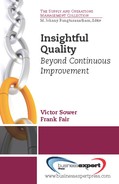A
Agile organizations, 57–58
Agility, 57
B
BEHAGS. See Big Hairy Audacious Goals
Benchmarking, 96–99
defined, 96
examples of insightful use of, 97–99
misconception about, 96
Beyond Performance, 37
Big Hairy Audacious Goals (BEHAGS), 72
Breakthrough improvement or radical change
Breakthrough improvements, 27
C
Canaiano, Donna, 56
Capabilities, 39
Change management, 99–102
force-field theory, 100
planned change model, 101
Change manager, 102–103
expert power for, 102
referent power for, 102
Continuous improvement (CI), 2, 27
insufficient for organizational success, 11–25
necessity for thinking beyond, 21–22
and product life cycle, 17–20
technology S-curve, 14–17
Continuous quality improvement (CQI), 27
Convergent technologies, opportunities and threats from, 23–24
Coordination and control, 39
Corporate Creativity, 58
Courageous leadership, 46–47
Cultural strength, 60
Culture and climate, 39
Customer orientation and understanding of customer needs, 59–60
D
Deming, W. Edwards, 6, 41–42, 51, 56, 76
Designing for Growth: A Design Thinking Tool Kit for Managers, 31
Direction, 38
Disruptive change
Diverse interactions, opportunities for, 52–53
Divided line, 28
Drucker, Peter, 14
E
Expectancy theory, 81–82
External environmental scanning, 88–90
External orientation, 40
F
Failure as opportunity to learn, 53–54
From Engineer to Manager: Mastering the Transition, 79
G
Greater Hippias, 2
H
House of quality, 90–96
creating, 92–94
insightful use of, 95–96
standard employment of, 91
technological integration, 95
I
Identity, 39
Innovation and execution, 11
Innovation and learning, 40
Insight
defined, 32, 45
developing, 33–37
Insightful individual
accountability, 39
becoming, 32–37
capabilities, 39
coordination and control, 39
culture and climate, 39
direction, 38
external orientation, 40
innovation and learning, 40
leadership, 39
motivation, 38
Insightful leadership, 45–46
Insightful organizations
characteristics of, 44–60
agile, 57–58
courageous leadership, 46–47
customer orientation and understanding of customer needs, 59–60
does not judge ideas too quickly, 58–59
failure as opportunity to learn, 53–54
insightful leadership, 45–46
intraorganizational communication, 54
open to ideas from all sources, 55
opportunities for diverse interactions, 52–53
personal developmental activities, 51–52
shared vision, 47–48
systems thinking, 55–57
tolerance for risk, 49
trust, 49–51
developing, 44
Instant pudding, 41
Intraorganizational communication, 54
Intrinsic motivation, 82
J
Jobs, Steve, 3–4, 7–9, 27, 35, 57, 59, 60
Jobs, Steve 10 commandments of, 4
Jury of expert opinion, 89–90
K
Keller & Price’s Five Framing Questions, 37, 39–40, 71
Knowledge management (KM) system, 78
L
Leadership, 39
Leadership sagacity
defined, 46
Long-term performance, 11
M
Managers
difference in thinking and skill set required by, 79
importance of business knowledge and technical knowledge, 80
performance measures, 81
promoting technical staff to management, 80
reward systems, 81–82
Market penetration rates, 22–23
for new products, 23
Mass customization, 58
Motivation, 38
N
New ways of thinking, 24–25
O
Organizational culture
change, example, 61–62
defined, 60
importance of, 60–61
P
Paradigm
defined, 11–12
Paradigm shifts, 3, 12–14
Paradigms lost, 62–67
Paradox of failure, 76–79
encourage right kind of mistakes, 77
fear of failure, 76
knowledge management system, role of, 78
mistakes as opportunity to learn, 77–78
reacting to failure, 78–79
reward systems, 79
Personal developmental activities, 51–52
Plato
concept of insight, 28–37
divided line, 28–37
hierarchy, 30, 31
invented the term “quality,” 5
and parallel between individual and organization, 37–41
Product life cycle, 17–20
creativity and innovation, 19
length of, 17
revitalized, 20
slide rule and pocket calculator, 21
stages of, 18–19
Q
Quality, 4–6
definitions of, 2, 5–6, 7
Garvin’s five approaches, 6
invention of term, 5
new ways of thinking about, 4–9
objective aspect of, 5
subjective aspect of, 5
transcendent approach, 6–9
Quality function deployment (QFD)
defined, 90–91
R
Reinforcement theory, 81
Republic, 28, 37
S
Sagacity. See Leadership sagacity
Shared vision, 47–48
example, 48–49
Short-term performance, 11
Standing operating procedures (SOPs), 44, 102
Strategic deployment, 73–74
milestones and due dates, 73–74
resources, 73
responsibilities, 73
Strategic evaluation and control, 74
importance of identifying true threat, 75–76
moving up a level, 74–75
Strategic planning, 70–73, 86
environmental scan, 71–72
mission and vision, 70–71
SWOT analysis, 71–72
Strategic quality management, 70–76
defined, 70
Strategic technological planning, 86
Strengths, Weaknesses, Opportunities, Threats (SWOT) analysis, 72
SWOT. See Strengths, Weaknesses, Opportunities, Threats
Symposium, 36
System, 55
Systems theory, 44
Systems thinking, 56
example, 56
Job’s awareness of, 57
T
Technological forecasting, insightful use of, 86–90
Technology S-curve, 15
replacement technologies and, 17
structure of, 16
Time series forecasting, 86–87
Moore’s law, 87
Tolerance for risk, 49
“Transition from Technical Expert to Effective Leader,” 79
Trust, 49–51
Judge’s practices for cultivating, 50
trusting followers, 49–50
trusting of self, 51
trustworthy leadership, 49–50
W
Welch, Jack, 62
